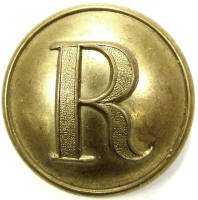
Civil War Relicman,
Harry Ridgeway
authentic Civil War relics, bought and sold.
relicman.com.
 |
Civil War Relicman,
|
| Winchester, Virginia
USA, changed hands 70 times in the Civil War!
authentic Civil War relics, bought and sold. relicman.com. |
|
| Civil War artillery, Relicman sales catalog. All items listed are authentic to the Civil War or as otherwise described. All artillery items listed have been disarmed. Any excavated relics have been recovered from private property with owners permission. |
| A1815...Rifled artillery projectile,
Hotchkiss design, Federal manufacture, bursting shell, pattern with
flame grooves, rounded nose, "case shot" lead balls packed loose without matrix or with asphalt matrix, iron separator bolt, lead band sabot, Hotchkiss brass time fuze, Ordnance rifle, 3in. Projectile was manufactured in the Federal arsenals following the invention of Andrew Hotchkiss. The
pattern consisted of three parts, a nose section containing the explosive charge,
a cast iron cup fitted on the bottom, and lead band sabot cast around the middle, on firing the cup would compress the lead
band sabot expanding it into the rifling. Some
of these shells were "common" or standard rounds, explosive charge only, or "case shot", filled with balls. This is "case shot", with a time fuze it was designed to be used against
troops by spreading large volume of fragments and balls over the open field of fighting. Lead balls were packed in sawdust only, early production, or black asphalt matrix, later production. The nose is rounded to accomodate the extra load of balls and the casting in the nose is thin to encourage breakage forward in the nose. There are two chambers in the nose, all of the powder is in the lower chamber, all of the balls are in the upper chamber, there is an iron seperator bolt in the middle, with a hole and a narrow metal channel to allow the flame to pass from the fuze to detonate the powder in the lower chamber. On detonation, the exploding powder in the base was expected to push the seperator bolt and the balls forward and out the weak top section of the nose. The nose was cast as one part, the bottom is solid, the separator bolt apparently was precast and imbedded in the core, then positioned after casting once the core was removed, it is larger than the fuze opening. Three flame grooves added so that flame from firing would pass
through the sabot and ignite the fuze. Fuze employed was a Hotchkiss brass time fuze, with slots and a flange, Jones pg. 87. Hotchkiss patent date was
cast, not stamped, into the base, "HOTCHKISS PATENT OCTOBER 9, 1855", and is typically
very weak and may have been omitted entirely as the molds wore down or were replaced. Reference: Dickey & George, Field Artillery (1993 Edition), pg. 167. Shell is cut exposing the interior, this is side 1 Shell is cut exposing the interior, this is side 2 Projectile measures: diameter 2.98in., length 6.5in. (excluding fuze), weight 8.6lb. Lead band sabot shows seven lands and grooves, fired from the Ordnance rifle. Hotchkiss brass time fuze intact. Projectile is disarmed, drill hole through paper section of the time fuze. Recovered: not known. For sale, Shell is cut exposing the interior, either half $225., both halves $375. Details click: http://relicman.com/artillery/RelicmanSalesArtillery-A1815.html. |